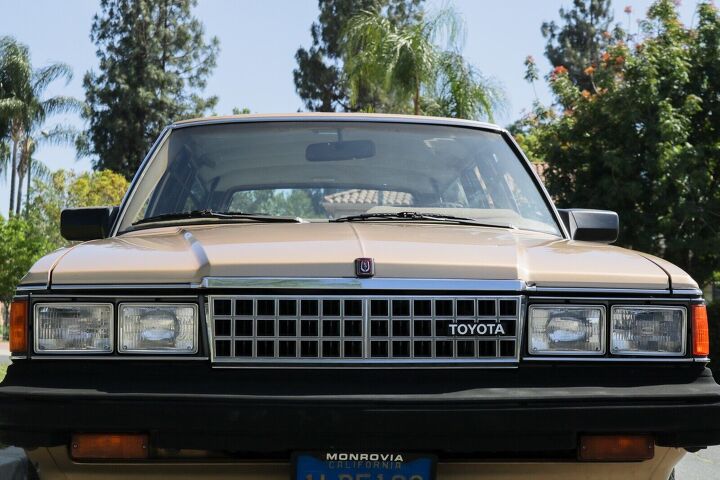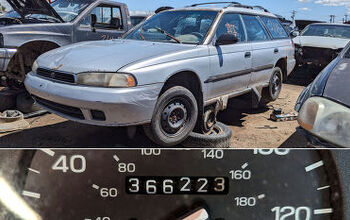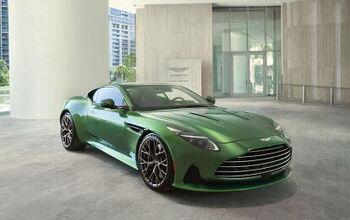TTAC Throwback: Why You Should Buy This 1984 Toyota Cressida Wagon

Before Lexus, there was Cressida. It was probably more of a Japanese take on a Buick- or Oldsmobile-style upper-middle-luxury car than the game changer Lexus would be, but that’s no mark against it. The first Toyota bearing the Cressida name became available in the U.S. in 1977, and they were decidedly trans-Pacific cars, bearing much resemblance to contemporary Detroit products. Interiors could be Brougham plush; some available upholstery fabrics wouldn’t look out of place in a bordello – or a Buick. However, the instrumentation was more complete than you’d find on most Detroiters.
Toyota sales literature of the time was dripping in upmarket advertising tropes like photos posing sedans in front of a posh hotel or a wagon with the tailgate open to receive some fine piece of antique furniture. Wagons usually wore woodgrain appliques, which no doubt reinforced the car’s upper-crust credentials in the eyes of potential buyers. Other markets had the option of a fetching little two-door hardtop model, which never made it to the U.S.
Cressidas were conservatively engineered, featuring unitary body construction, a MacPherson strut front suspension, and a live-axle rear suspension. They shared a lot of oily bits with their sporty Supra stablemate, including a SOHC inline-six-cylinder engine and suspension components.
Toyota refreshed the Cressida on a four-year cycle, and the confidently styled 1982 model hit showrooms in 1981, in sedan or long-roof flavor in the U.S. Its front aspect was restrained, sporting quad rectangular headlights and a demure grille. Well-proportioned wheel arches relieved the rectilinear side profile; a descending accent line is the only touch of eccentricity in this utterly sober design; it also harkened back to the preceding Cressida. Slender pillars and an upright windshield with a bright surround completed the dignified package.
Roughly the size of a Ford Fairmont, the 1982 Cressida was short of one luxury space; the EPA classified the sedan as a subcompact based on interior volume. Still, everything was well laid out and well made. Upholstery ranged from sensible velours to Iacocca-esque, button-tufted leather; it was “glove-soft,” according to the brochure.
As the crown of the Toyota lineup (pun very much intended), the 1982 Cressida benefited from the best the company could offer – including the jewel-like 5M-GE engine. That 2.8-liter inline-six spins sweetly from idle to redline and delivers its horsepower with utmost civility. A wide-angle aluminum cylinder head with belt-driven twin camshafts and hemispherical combustion chambers meant good volumetric efficiency. Electronic fuel injection meant precise fuel metering and helped with meeting emissions requirements. Sedans now had a fully-independent suspension too, but wagons continued to make do with a live rear axle.
The Cressida would go through another two generations before finally bowing out of the U.S. market in 1992.
Why This Car
The Good:
It’s said that gentlemen drive cars with cylinders in multiples of six. That old chestnut usually applies to British machines with angelic ladies perched on their radiators, not mass-produced 1980s iron. But, the Cressida has an inline-six, and by all accounts, it’s a gem.
Offered by the original owner, this wagon appears to be the proverbial garage-kept survivor that has benefitted from a life of ease in salt-free California. It’s low mileage, too, showing just over 70,000 on the clock. The seller claims to have had it serviced regularly; even the AC is said to work.
The Not So Good:
Well, it’s not cheap, even when judged by today’s standards, and it looks as though there may be some discoloration of the front door panels, though it could simply be the way the nap of the velour is laying.
Things To Watch Out For When Buying a Toyota Cressida.
First, find one that doesn't have tinworm, then sniff the transmission fluid (on automatics), ensuring it doesn’t have the whiff of death (a rotten, burned smell) and that it shifts smoothly. Sedans could be had with a manual, which should shift easily, be relatively quiet, and not pop out of gear.
Engines are very durable, so long as timing belts get changed every 60,000 miles or so and the coolant gets flushed regularly.
Yes, we all know Toyotas are as reliable as gravity (most of the time), but even a Cressida isn’t immune to deteriorating suspension bushings, belts, and hoses. Jack up the front end and check the suspension for undue play. Do the same for the rear if it’s a sedan equipped with IRS.
Cressidas and their kin were common enough that service parts like timing belts, distributors, shocks, struts, and the like can be had from sources like RockAuto or your preferred local parts house. Trim pieces and body panels will probably be the biggest challenge, so try to find as intact a car as possible.
To Sum It Up
It wasn’t that long ago I would have cackled at the suggestion of a beige Toyota Cressida with a starting bid of $9,999, but here we are. A GM B-body wagon that shows as nicely as this car would be priced similarly, so why not, unless a 5,000 lb tow capacity and the ability to swallow a 4 x 8 sheet of plywood are must-haves on your classic car checklist? Besides, a twin-cam, inline-six powered, rear-wheel-drive wagon is cool in my book. Buy this one and take care of it like a Picasso; they aren’t making any more.
Once more, click here for the full listing.
TTAC Throwback
TTAC Throwback is a series devoted to cars we think deserve to be owned by someone who really loves them. Just imagine Sarah McLachlan crooning In the Arms of an Angel as the camera pans past a deserving car up for adoption, hoping desperately that it doesn't get recycled into a Nissan Versa (I’ve, I’ve got something in my eye). Now go ahead, put in your bid; there now, don’t you feel better? You’re doing the right thing!

There's an old quote which goes something like: "One drives a Bentley, one is driven in a Rolls, and one presents a Delage to one's mistress." As for me, I'll stick to my Lincoln. You'll find my byline at Autoguide.com, Crankshaft, Old Cars Weekly, and sundry other publications.
More by Bryan Raab Davis
Latest Car Reviews
Read moreLatest Product Reviews
Read moreRecent Comments
- Whynotaztec Like any other lease offer it makes sense to compare it to a purchase and see where you end up. The math isn’t all that hard and sometimes a lease can make sense, sometimes it can’t. the tough part with EVs now is where is the residual or trade in value going to be in 3 years?
- Rick T. "If your driving conditions include near-freezing temps for a few months of the year, seek out a set of all-seasons. But if sunshine is frequent and the spectre of 60F weather strikes fear into the hearts of your neighbourhood, all-seasons could be a great choice." So all-seasons it is, apparently!
- 1995 SC Should anyone here get a wild hair and buy this I have the 500 dollar tool you need to bleed the rear brakes if you have to crack open the ABS. Given the state you will. I love these cars (obviously) but trust me, as an owner you will be miles ahead to shell out for one that was maintained. But properly sorted these things will devour highway miles and that 4.6 will run forever and should be way less of a diva than my blown 3.8 equipped one. (and forget the NA 3.8...140HP was no match for this car).As an aside, if you drive this you will instantly realize how ergonomically bad modern cars are.These wheels look like the 17's you could get on a Fox Body Cobra R. I've always had it in the back of my mind to get a set in the right bolt pattern so I could upgrade the brakes but I just don't want to mess up the ride. If that was too much to read, from someone intamately familiar with MN-12's, skip this one. The ground effects alone make it worth a pass. They are not esecially easy to work on either.
- Macca This one definitely brings back memories - my dad was a Ford-guy through the '80s and into the '90s, and my family had two MN12 vehicles, a '93 Thunderbird LX (maroon over gray) purchased for my mom around 1995 and an '89 Cougar LS (white over red velour, digital dash) for my brother's second car acquired a year or so later. The Essex V6's 140 hp was wholly inadequate for the ~3,600 lb car, but the look of the T-Bird seemed fairly exotic at the time in a small Midwest town. This was of course pre-modern internet days and we had no idea of the Essex head gasket woes held in store for both cars.The first to grenade was my bro's Cougar, circa 1997. My dad found a crate 3.8L and a local mechanic replaced it - though the new engine never felt quite right (rough idle). I remember expecting something miraculous from the new engine and then realizing that it was substandard even when new. Shortly thereafter my dad replaced the Thunderbird for my mom and took the Cougar for a new highway commute, giving my brother the Thunderbird. Not long after, the T-Bird's 3.8L V6 also suffered from head gasket failure which spelled its demise again under my brother's ownership. The stately Cougar was sold to a family member and it suffered the same head gasket fate with about 60,000 miles on the new engine.Combine this with multiple first-gen Taurus transmission issues and a lemon '86 Aerostar and my dad's brand loyalty came to an end in the late '90s with his purchase of a fourth-gen Maxima. I saw a mid-90s Thunderbird the other day for the first time in ages and it's still a fairly handsome design. Shame the mechanicals were such a letdown.
- FreedMike It's a little rough...😄








































Comments
Join the conversation
7MGTE should be drop in. It would still be slow though.
Do you accept parts sales?